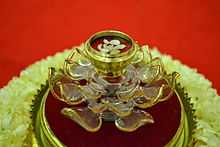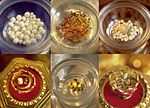Śarīra
| Śarīra | |||||||
|
Various sarira from the Buddha and various students. Part of a collection by Maitreya Project | |||||||
| Chinese name | |||||||
|---|---|---|---|---|---|---|---|
| Traditional Chinese | 舍利 or 舍利子 | ||||||
| Simplified Chinese | 舍利 or 舍利子 | ||||||
| |||||||
| Tibetan name | |||||||
| Tibetan | རིང་བསྲེལ། | ||||||
| |||||||
| Vietnamese name | |||||||
| Vietnamese | Xá Lợi | ||||||
| Korean name | |||||||
| Hangul | 사리 | ||||||
| Hanja | 舍利 | ||||||
| |||||||
| Japanese name | |||||||
| Kanji | 仏舎利 | ||||||
| Hiragana | ぶっしゃり | ||||||
| |||||||
| Sanskrit name | |||||||
| Sanskrit | शरीर (śarīra) | ||||||
| Thai name | |||||||
| Thai | พระบรมสารีริกธาตุ | ||||||
Śarīra (Sanskrit: शरीर) is a generic term referring to "Buddhist relics", although in common usage it usually refers to pearl or crystal-like bead-shaped objects that are purportedly found among the cremated ashes of Buddhist spiritual masters. Relics of the Buddha after cremation are termed dhatu in Maha Parinibbana Sutta.[1] Sarira are held to emanate or incite 'blessings' and 'grace' (Sanskrit: adhishthana) within the mindstream and experience of those connected to them.[2] Sarira are also believed to ward off evil in the Himalayan Buddhist tradition.
Terminology
The term sarira or "sharira" (शरीर) is a loanword from Sanskrit. The term "Sarira" originally means "body" in Sankrit, but when used in Buddhist Sanskrit texts to mean "relics", it is always used in the plural: śarīrāḥ. The term ringsel is a loanword from the Tibetan language. Both of these terms are ambiguous in English; they are generally used as synonyms, although according to some interpretations, ringsels are a subset of sariras.
Sarira can refer to:
- Dharma body sariras, or sutras as told by the Buddha, according to Din Fu Bao's Dictionary of Buddhist Terms, a Dharma body sarira is "the Sutra as told by the Buddha: That which is unchanging in what is told by the Buddha, is of the same property as the essence of the Buddha himself, hence it is called the 'dharma body sarira'".
- Corporeal and full body sariras, the cremated remains of the Buddha (or any other spiritual master), but can also be used to refer other remains (for instance, a finger bone), or a preserved body, similar to the Roman Catholic incorruptibles. Full body sariras refers to the mummified remains of spiritual masters.
- Broken body sariras refers specifically to cremated remains.
- Sariras or Ringsels, when used without qualification, the term sarira generally refers to the pearl-like remnant of a master left after cremation.
Pearl-like Sariras
Although the term sarira can be used to refer to a wide variety of Buddhist relics, as listed above, it is generally used to refer to pearl or crystal-like bead-shaped objects that are purportedly found among the cremated ashes of Buddhist spiritual masters.
These objects are considered relics of significant importance in many sects of Buddhism since they are believed to embody the spiritual knowledge, teachings, realizations or living essence of spiritual masters. They are taken as evidence of the masters' enlightenment and spiritual purity. Some believe that sariras are deliberately left by the consciousness of a master for veneration, and that the beauty of the sariras depends on how well the masters had cultivated their mind and souls. Sariras come in a variety of colors, and some are even translucent.
Sariras are typically displayed in a glass bowl inside small gold urns or stupas as well as enshrined inside the master's statue. Sarira are also believed to mysteriously multiply while inside their containers if they have been stored under favorable conditions. Saffron threads are sometimes placed within or around the bowl containing individual sarira as an offering.
In the Korean Samguk Yusa it is said that the monk, Myojong, received a sarira from a turtle which caused others to treat the monk better.[3]
The occurrence of sarira is not restricted to ancient times, and many Buddhists have shown that sarira are not limited to humans or masters. The cremation of Tong Xian (通显法师) in March 1991 reportedly yielded 11,000 sariras. Many Pure Land Buddhist texts also report sariras of many adherents, some occurring recently.[4] Parrots and a dog have been reported to leave sariras after their cremation.[5][6]
Some Buddhists associate a student's spiritual life with the amount and condition of the sarira they leave after cremation. Many Pure Land Buddhists believe Amitabha's power manifests cremated remains into sarira. Many claim that pearls of sarira rain at the funerals of eminent monks. There are reports that sarira may appear, multiply or disappear, depending on a keeper's thoughts.[7] One's vow may also be important. One legend holds that the translator Kumārajīva wanted to demonstrate that his translations were not false; as a result his tongue remained intact after cremation.
Explanations

There is evidence that under certain conditions of heating, human bones can form crystalline structures.[8] In one chemical analysis, sariras were found to be composed of the constituent elements of both bones and stones.[9] Some living men appeared sarira.[10]
Documentary films
Pearl relics are documented in the 2008 film, Unmistaken Child, among the cremation ashes of Geshe Lama Konchog.
In Javanese Language
Javanese has a strong historical bond with the Hindu tradition and Sanskrit liturgical language. Śarīra is also used in Archaic (Kawi) Javanese, preserving its original meaning of 'body' or 'human body'. The word also finds its way into the modern Javanese language as "slira" with the same meaning. "Sliramu" (strictly translated as 'your body') and "sliraku" (strictly translated as 'my body') are usually used in poems or songs to replace "you" and "I", respectively. The word is not common but is used in both oral and written contexts.
See also
- Cetiya
- Gallstones
- Rainbow body
References
- ↑
- ↑ Martin, Dan (1994). 'Pearls from Bones: Relics, Chortens, Tertons and the Signs of Saintly Death in Tibet'. Numen, Vol. 41, No. 3. (Sep., 1994), Source: (accessed: Friday April 23, 2010), p.274.
- ↑ Il-yeon: Samguk Yusa: Legends and History of the Three Kingdoms of Ancient Korea, translated by Tae-Hung Ha and Grafton K. Mintz. Book Two, page 100f. Silk Pagoda (2006). ISBN 1-59654-348-5
- ↑ 真佛報(一九九二年元月份)
- ↑ 物猶如此 動物念佛往生西方極樂世界實錄
- ↑ "(202) 千里之外的看見". Hklts.org.hk. Retrieved 2012-12-12.
- ↑ "妙雲集下編之十一". Shengyimaster.org. Retrieved 2012-12-12.
- ↑ "Scanning electron microscope observations of heat-treated human bone". Forensic Sci. Int. 74 (1-2): 29–45. June 1995. doi:10.1016/0379-0738(95)01735-2. PMID 7665130.
- ↑ "A Brief Introduction of Forshang World Foundation". Forshang.org. Retrieved 2012-12-12.
- ↑ 神奇舍利子 - 陈晓东佛教作品选
